The White-capped Albatross, Thalassarche steadi, is a captivating seabird found primarily in the Southern Hemisphere’s subantarctic and temperate waters.
Renowned for its impressive wingspan, striking plumage, and nomadic lifestyle, this iconic species navigates the open ocean with grace and agility.
With its distinctive white cap, black facial markings, and adept hunting skills, the White-capped Albatross embodies the beauty and resilience of marine avifauna.
This introduction offers a glimpse into the captivating world of one of the Southern Ocean’s most majestic inhabitants. So, stay sharp till the end.
Physical Characteristics of White-capped Albatross
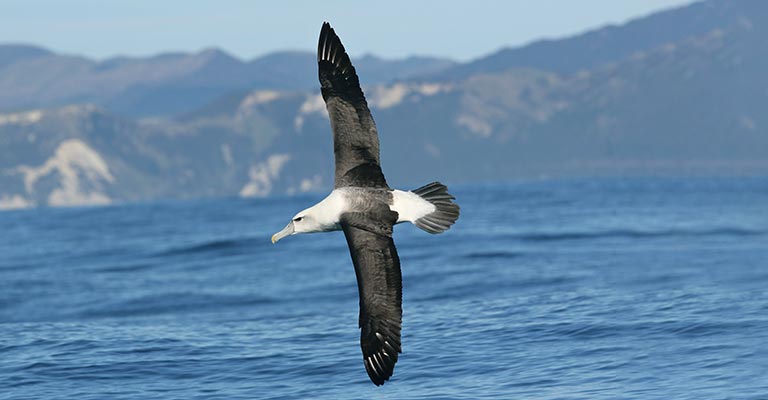
The White-capped Albatross (Thalassarche steadi) is a magnificent seabird known for its distinctive appearance and size. Here are some of the fundamental physical characteristics that help in identifying this particular bird:
Size and Shape
White-capped Albatrosses are large birds with long, narrow wings spanning between 2.25 and 2.7 meters (7.4 to 8.9 feet). Their body length typically ranges from 85 to 96 centimeters (33 to 38 inches).
They have a robust body and a graceful gliding flight pattern, utilizing their expansive wings to soar effortlessly over the ocean for hours.
Plumage
As the name suggests, White-capped Albatrosses have a distinctive white cap on their head, contrasting sharply with the black feathers on their face and neck.
The rest of their plumage is predominantly white, with grayish-black wings and a white underbelly. The contrast between the dark wings and the white body is striking in flight.
Bill and Eyes
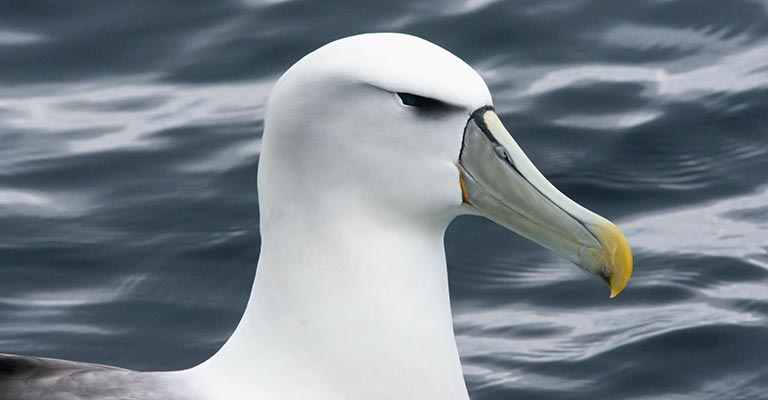
They have a large, pale yellow bill with a pinkish-orange tip. Their eyes are dark brown and are encircled by a narrow, black eye ring, adding to their intense and striking appearance.
Tail
The tail of the White-capped Albatross is relatively short compared to its body size, with squared-off ends. It is blackish-brown, often blending in with the dark wings during flight.
Legs and Feet
Their legs are short and located toward the rear of their body, making them well-adapted for swimming and floating on the ocean surface.
Their webbed feet are mainly white with blackish coloring on the edges, aiding propulsion through the water.
Flight Pattern
White-capped Albatrosses exhibit a characteristic flight pattern characterized by effortless gliding and soaring over the ocean waves.
They use dynamic soaring techniques, taking advantage of wind gradients close to the ocean surface to gain lift and minimize energy expenditure during long-distance flights.
Behavior
These birds are highly social and often seen in large flocks, particularly during feeding frenzies or when scavenging for food behind fishing vessels.
They are skilled scavengers and opportunistic feeders, preying on fish, squid, and other marine organisms.
Distribution
White-capped Albatrosses are primarily found in the Southern Hemisphere, particularly in the subantarctic and temperate waters of the southern oceans.
They breed on remote islands, including the Falkland Islands, South Georgia, and the South Sandwich Islands.
The White-capped Albatross can be readily identified by its large size, striking plumage with a white cap, distinctive bill and eye coloration, unique flight pattern, and preference for remote oceanic habitats.
These physical characteristics make it a remarkable and easily recognizable seabird in its natural environment.
Taxonomy of White-capped Albatross
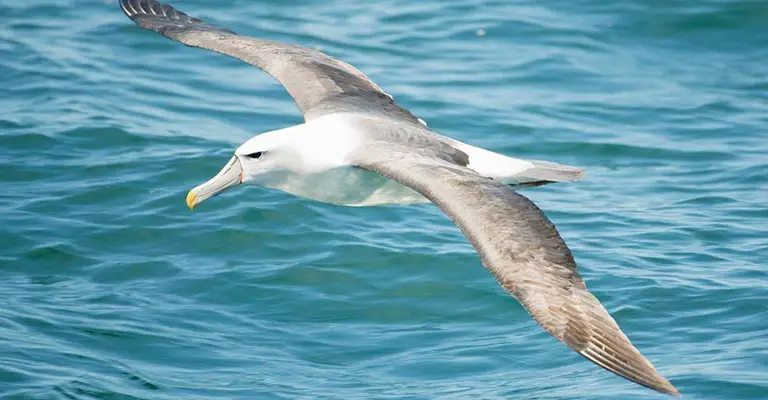
Here you will find a table detailing the taxonomy of the White-capped Albatross below:
| Taxonomic Rank | Classification |
| Domain | Eukaryota |
| Kingdom | Animalia |
| Phylum | Chordata |
| Class | Aves |
| Order | Phaethontiformes |
| Family | Diomedeidae |
| Genus | Thalassarche |
| Species | T. cautaSubspecies: T. c. steadi |
The White-capped Albatross (Thalassarche steadi) belongs to the family Diomedeidae within the order Procellariiformes.
This order encompasses various seabirds characterized by their long wings, tube-like nostrils, and salt glands for excreting excess salt.
Within the family Diomedeidae, albatrosses are further divided into several genera, with Thalassarche being one of them.
The White-capped Albatross is classified explicitly under the genus Thalassarche, which includes other species like the Black-browed Albatross and the Grey-headed Albatross.
Its species name, steadi, honors ornithologist Colonel William Robert Stead, who contributed significantly to the study of seabirds.
This taxonomy provides a systematic framework for understanding the White-capped Albatross’s evolutionary relationships and ecological roles within the broader context of avian biodiversity.
Common Food of White-capped Albatross
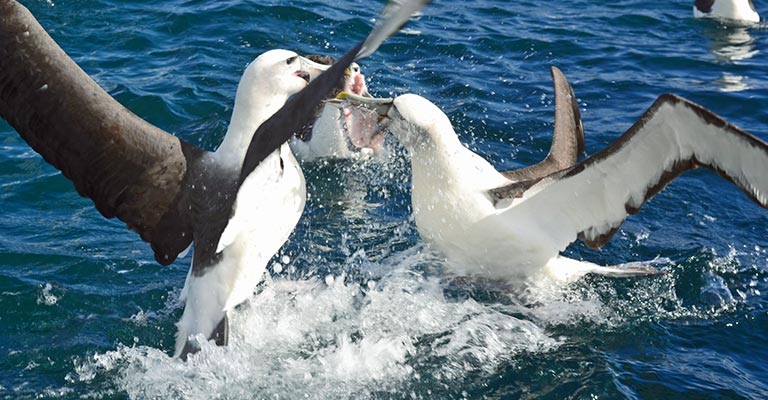
The White-capped Albatross primarily feeds on various marine organisms, exhibiting opportunistic feeding behaviors as they scavenge and forage over vast oceanic expanses. Their typical food habits include:
- Fish: White-capped Albatrosses feed on small to medium-sized fish species, such as lanternfish, mackerel, and squid.
- Squid: Squid is a significant component of their diet, and they often snatch them from the ocean surface or dive to catch them underwater.
- Crustaceans: They also consume crustaceans like krill and shrimp, which are abundant in the waters they inhabit.
- Cephalopods: Along with squid, they may consume other cephalopods like octopus and cuttlefish.
- Carrion: These opportunistic feeders scavenge on carrion, including fish scraps discarded by fishing vessels or carcasses of other marine animals floating on the surface.
The White-capped Albatross displays a varied diet typical of many seabirds, relying on a mix of fish, squid, crustaceans, and carrion to meet their nutritional needs while traversing the open ocean.
White-capped Albatross Life History
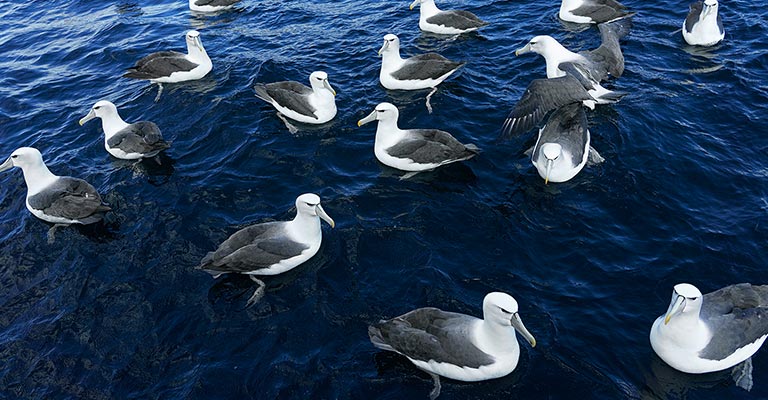
The White-capped Albatross (Thalassarche steadi) is a majestic seabird renowned for its graceful flight and striking appearance.
With its white-capped head and expansive wingspan, this species captivates birdwatchers and researchers alike. Understanding its life history sheds light on its remarkable adaptations and conservation needs.
Hunting Habit
White-capped Albatrosses are skilled hunters, utilizing their keen eyesight to spot prey from great distances while soaring over the open ocean.
They primarily feed on fish, squid, and crustaceans, employing various foraging techniques such as surface dipping, plunge diving, and scavenging behind fishing vessels.
Habitat
These seabirds inhabit remote oceanic regions, including subantarctic and temperate waters of the Southern Hemisphere.
They frequent areas with abundant marine life, such as continental shelves, upwelling zones, and oceanic currents.
Range Map
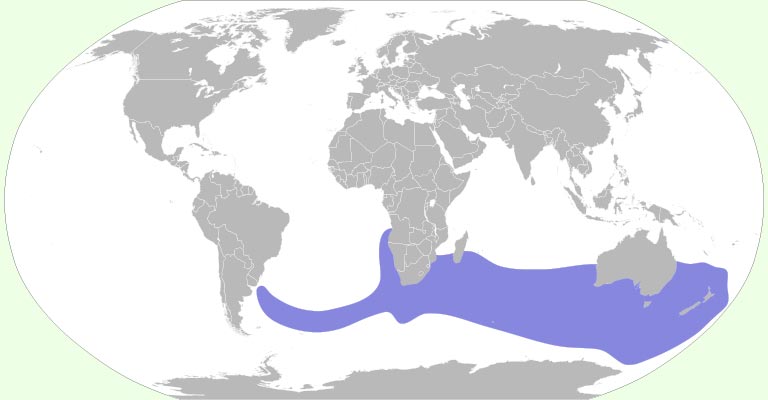
The range of the White-capped Albatross spans vast stretches of the Southern Ocean, encompassing breeding colonies on islands such as the Falkland Islands, South Georgia, and the South Sandwich Islands.
Nesting
White-capped Albatrosses form breeding colonies on isolated islands, typically nesting on cliffs or tussock grass-covered slopes.
They construct simple nests using grass, feathers, and other available materials, often reusing the same nesting sites year after year.
Here’s a table for you detailing the nesting details of the White-capped Albatross:
| Nesting Details | Facts |
| Clutch Size | Typically, one brood per breeding season |
| Number of Broods | Simple nest made of grass, feathers, and other materials, located on cliffs or tussock grass-covered slopes. |
| Egg Length | Approximately 10 to 12 centimeters (4 to 5 inches) |
| Egg Width | Approximately 6 to 7 centimeters (2.5 to 3 inches) |
| Incubation Period | Around 65 to 75 days |
| Nestling Period | Approximately 5 to 6 months |
| Egg Description | Pale creamy-white with a smooth surface |
| Nest Description | Simple nest made of grass, feathers, and other materials, located on cliffs or tussock grass-covered slopes |
This table provides a concise overview of the nesting habits and characteristics of the White-capped Albatross.
Breeding
Breeding pairs engage in elaborate courtship displays, with synchronized dancing and vocalizations strengthening pair bonds.
Females lay a single egg, which both parents take turns incubating for around two months. Chicks hatch in the austral summer and are cared for by both parents until fledging.
Diseases and Treatment
White-capped Albatross populations face threats from diseases such as avian cholera and avian pox, which can spread rapidly within crowded breeding colonies.
Conservation efforts often involve monitoring and treating affected individuals and implementing measures to minimize disease transmission.
Conservation
Conservation initiatives for White-capped Albatrosses focus on protecting breeding colonies, reducing bycatch in fisheries, and mitigating the impacts of habitat degradation and climate change.
International collaboration and marine protected areas play crucial roles in safeguarding the future of this iconic species.
The life history of the White-capped Albatross underscores the interconnectedness between seabirds and marine ecosystems, highlighting the importance of conservation efforts to ensure their survival in the face of ongoing threats.
10 Fun Facts About White-capped Albatross
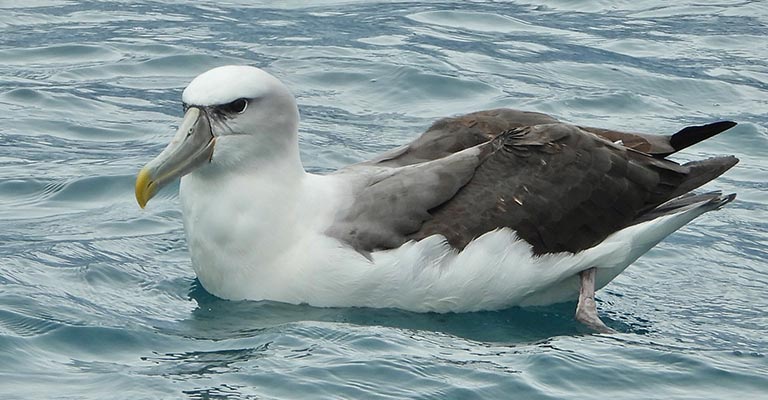
The White-capped Albatross (Thalassarche steadi) is a fascinating seabird known for its impressive size, striking appearance, and remarkable adaptations to life on the open ocean. Here are ten fun facts about this fantastic species:
- Impressive Wingspan: White-capped Albatrosses boast an incredible wingspan, spanning between 2.25 and 2.7 meters (7.4 to 8.9 feet), allowing them to glide effortlessly over vast stretches of ocean.
- Long-Lived Aviators: These seabirds have an impressive lifespan, with some individuals known to live for over 40 years, making them one of the longest-lived birds in the world.
- Dynamic Soaring: White-capped Albatrosses are masters of dynamic soaring, utilizing wind gradients close to the ocean surface to gain lift and travel incredible distances with minimal effort.
- Distinctive Plumage: The white cap on their head contrasts sharply with the black feathers on their face and neck, giving them an easily recognizable distinctive appearance.
- Social Birds: White-capped Albatrosses are highly social creatures, often seen in large flocks, particularly during feeding frenzies or when scavenging for food behind fishing vessels.
- Nomadic Lifestyle: These seabirds are true wanderers of the open ocean, with individuals traveling thousands of kilometers in search of food and suitable breeding sites.
- Breeding Rituals: Breeding pairs engage in elaborate courtship displays, involving synchronized dancing and vocalizations, to strengthen pair bonds and ensure reproductive success.
- Monogamous Bonds: Once paired, White-capped Albatrosses typically mate for life, returning to the same breeding colony year after year to raise their chicks.
- Vocal Communicators: These birds are known for their distinctive vocalizations, which play a crucial role in communication within breeding colonies and during courtship rituals.
- Conservation Concerns: Despite their remarkable adaptations, White-capped Albatrosses face threats from habitat destruction, bycatch in fisheries, and climate change, highlighting the importance of conservation efforts to protect this iconic species for future generations.
These fun facts offer a glimpse into the intriguing world of the White-capped Albatross, highlighting its unique characteristics and challenges in its oceanic realm.
Wrapping Up
The White-capped Albatross epitomizes the beauty and resilience of seabirds with its majestic presence and remarkable adaptations for life on the open ocean.
From its impressive wingspan and distinctive plumage to its intricate breeding rituals and nomadic lifestyle, this species captivates the imagination of bird enthusiasts and researchers alike.
However, amidst its natural splendor lies a story of conservation concern, as human activities threaten its habitat and survival.
As stewards of the planet, we must prioritize efforts to protect and preserve the habitats of the White-capped Albatross, ensuring that future generations can continue to marvel at the grace and magnificence of this iconic seabird.
Through collaboration and conservation initiatives, we can safeguard the future of the White-capped Albatross and other marine species for generations to come.